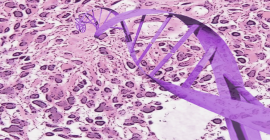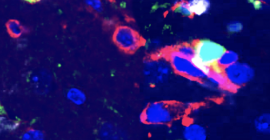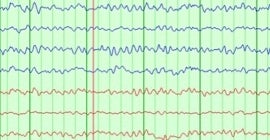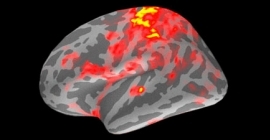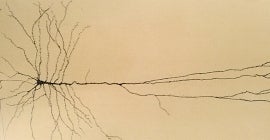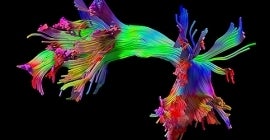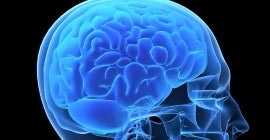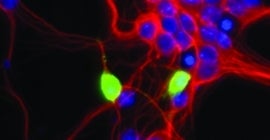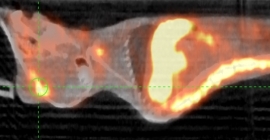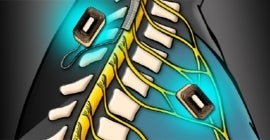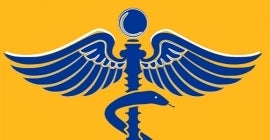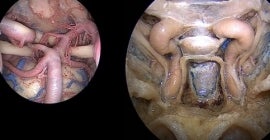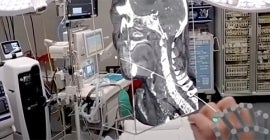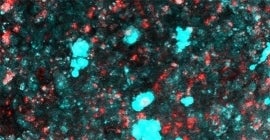The University of Pittsburgh Department of Neurological Surgery operates a number of specialized research laboratories, each focusing on a unique area. These laboratories include:
Brain Tumor Biology and Therapy Laboratory
The Brain Tumor Biology and Therapy Laboratory, under the direction of Sameer Agnihotri, PhD, studies pediatric and adult high-grade gliomas (HGG) and diffuse intrinsic pontine gliomas (DIPG).
Brain Tumor Evolution & Therapy Laboratory
The Laboratory of Brain Tumor Evolution & Therapy, under the direction of Baoli Hu, PhD, studies the genetic and epigenetic events contributing to the evolution of brain tumors.
Brain Tumor Nanotechnology Laboratory
UPMC Hillman Cancer Center lab directed by Costas G. Hadjipanayis, MD, PhD, involved in the testing of nanoparticle constructs for the targeted imaging and therapy of patient-based brain tumor models.
Clinical Neurophysiology Laboratory
The Clinical Neurophysiology Laboratory, led by Parthasarathy Thirumala, MD, MS, studies the diagnostic value of intraoperative neuromonitoring (IONM) during surgery to detect perioperative neurological disorders.
Cognitive Neurodynamics Laboratory
The Laboratory of Cognitive Neurodynamics, under the direction of Avniel Ghuman, PhD, studies how our brain turns what falls upon our eyes into the rich meaningful experience that we perceive in the world around us.
Cortical Systems Laboratory
Neuroscience lab, under the direction of Jorge Gonzalez-Martinez, studying brain electrophysiology and behavior in patients undergoing epilepsy and movement disorder surgery.
Fiber Tractography Lab
The Fiber Tractography Lab—under the direction of Frank Yeh, PhD—is focused on the application of High-Definition Fiber Tractography for presurgical planning and intraoperative navigation to facilitate brain function preservation.
Molecular Tumor Personalized Precision Lab
The Molecular Tumor Biology and Personalized Precision Therapy Lab, directed by Pascal Zinn, focuses on personalized patient-centered care for brain and spinal tumors
Neuroapoptosis Laboratory
The Neuroapoptosis Laboratory, under the direction of Robert Friedlander, MD, studies the basic mechanisms of apoptosis, as mediated by the caspase apoptotic family in neurologic diseases.
Pediatric Neurosurgery ImmunoOncology Laboratory
The Pediatric Neurosurgery ImmunoOncology Laboratory (PNIO), led by Gary Kohanbash, PhD, seeks to develop novel immuno-oncology approaches to treat deadly pediatric central nervous system tumors.
Spinal Cord Stimulation Lab
The Spinal Cord Stimulation Laboratory, under the direction of Marco Capogrosso, PhD, studies the interactions between electrical stimulation and the dynamics of spinal circuits.
Spine Computational Outcomes Learning Institute
SCOLI, co-directed by Nitin Agarwal, MD, and D. Kojo Hamilton, MD, is dedicated to advancing neurosurgical patient care using cutting-edge clinical and translational science.
Surgical Neuroanatomy Lab
The Surgical Neuroanatomy Lab (SNL), led by George Zenonos, MD, has a dual educational and research role aiming to improve surgical techniques and outcomes by mastering knowledge of relevant surgical neuroanatomy.
Surreality Lab
The Surreality Lab, under the direction of Edward Andrews, MD, features cutting-edge research and development in spatial computing, artificial intelligence/machine learning and robotics.
Translational Neuro Oncology Lab
The Laboratory for Translational Neuro Oncology, led by Kalil Abdullah, MD, develops novel preclinical models of glioma and identifies drug targets for early-phase clinical trials in patients with malignant brain tumors.

